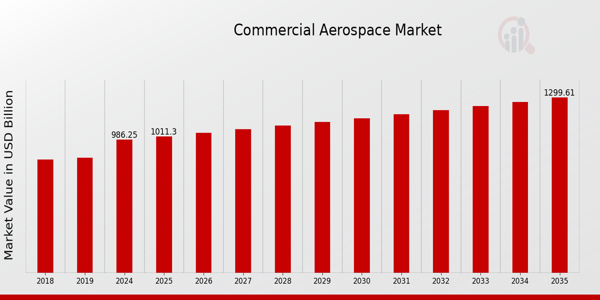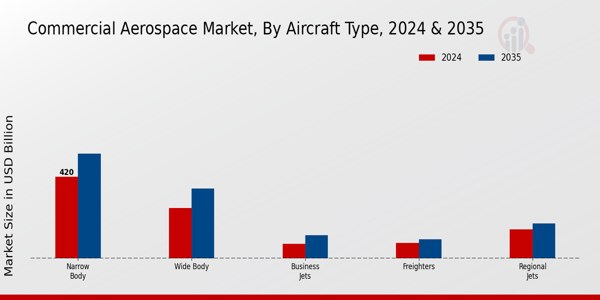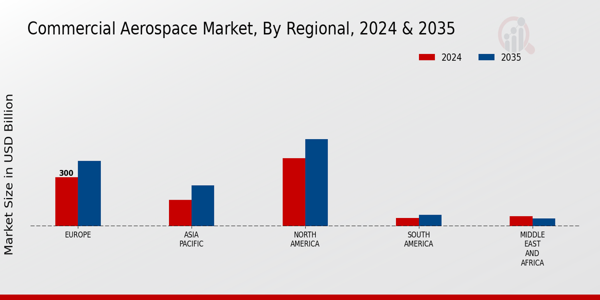Commercial Aerospace Market Summary
As per Market Research Future Analysis, the Global Commercial Aerospace Market was valued at 961.82 USD Billion in 2023 and is projected to grow to 1,300 USD Billion by 2035, with a CAGR of 2.54% from 2025 to 2035. The market is driven by increasing global air passenger traffic, technological advancements, and the rise of low-cost carriers. Key players are focusing on sustainability and digitalization to enhance operational efficiency and meet evolving consumer demands.
Key Market Trends & Highlights
Significant trends shaping the Commercial Aerospace Market include technological innovation and sustainability efforts.
- The market is expected to reach 986.25 USD Billion by 2024.
- Narrow Body aircraft segment valued at 420.0 USD Billion in 2024.
- Low-Cost Carriers accounted for 30% of the global airline market share in 2019.
- North America leads the market with a valuation of 415.0 USD Billion in 2024.
Market Size & Forecast
2023 Market Size: USD 961.82 Billion
2024 Market Size: USD 986.25 Billion
2035 Market Size: USD 1,300 Billion
CAGR (2025-2035): 2.54%
Largest Regional Market Share in 2024: North America.
Major Players
Key Companies include Lockheed Martin, Bombardier, Airbus, Boeing, and Honeywell.
Key Commercial Aerospace Market Trends Highlighted
Significant trends in the Commercial Aerospace Market include the growing focus on sustainability and eco-friendly technologies, as manufacturers and airlines increasingly aim to reduce their carbon footprint.
Innovations such as electric and hybrid propulsion systems are gaining traction, alongside advancements in lightweight materials that contribute to fuel efficiency.
The rising demand for air travel, particularly in emerging markets, remains a vital driver for the industry. This increased demand has prompted airlines to expand their fleets and customer offerings, creating a significant opportunity for manufacturers. Furthermore, there is a noticeable shift towards digitalization within aerospace operations.
Artificial intelligence, big data analytics, and the Internet of Things are being implemented to optimize maintenance practices and increase operational efficiency.
This trend not only resolves operational challenges but also presents opportunities for cost savings and improved consumer experiences.
The demand for modern aircraft with enhanced reliability and flexibility has been further exacerbated by the recent drive for increased air travel connectivity in response to pandemic-related disruptions. This changing demand landscape fosters innovation and adaptability among established firms and creates an opportunity for new entrants.
The promotion of research and development initiatives that are responsive to evolving consumer preferences and global regulations regarding environmental and safety standards is contingent upon the establishment of partnerships between governments and private enterprises.
In general, the global commercial aerospace sector's dynamic nature offers a plethora of opportunities for development as stakeholders collaborate to shape the industry's future.

Source: Primary Research, Secondary Research, Market Research Future Database and Analyst Review
Commercial Aerospace Market Drivers
Increasing Global Air Passenger Traffic
One of the most significant drivers for the Commercial Aerospace Market Industry is the consistently increasing air passenger traffic across the globe. The International Air Transport Association reported that in 2019, air travel demand grew by 4.2% over the previous year, translating to over 4.5 billion passengers transported.
This trend has remained resilient despite various global challenges and is expected to continue, with projections estimating that global passenger numbers will reach 8.2 billion by 2037.
This surge in air travel directly correlates to the need for more aircraft, thereby bolstering the commercial aerospace sector. Established aerospace players such as Boeing and Airbus have already begun to ramp up production to meet this rising demand, illustrating the market's responsiveness to passenger traffic growth.
Moreover, various regional governments are investing in airport infrastructure and policies that promote air travel, further propelling market growth.
Technological Advancements
Technological innovation is a critical driver of the Commercial Aerospace Market Industry, exemplified by the rise of fuel-efficient aircraft designs.
According to the European Commission, advances in composite materials and aerodynamics have helped improve aircraft fuel efficiency by approximately 15-20% in the past decade. Major manufacturers like Boeing and Airbus are investing significantly in Research and Development to integrate these technologies into their new fleets.
The introduction of new aircraft models equipped with advanced avionics and eco-friendly propulsion systems further exemplifies this trend.
As airlines worldwide seek to reduce operational costs and meet stringent environmental regulations, the demand for technologically advanced aircraft continues to rise, which in turn stimulates the commercial aerospace market.
Growing Demand for Low-Cost Carriers
The emergence and growth of low-cost carriers (LCCs) have transformed the Commercial Aerospace Market Industry. Data from the International Air Transport Association indicates that LCCs accounted for 30% of the global airline market share in 2019, a figure that is expected to increase.
These carriers drive demand for cost-effective single-aisle aircraft, allowing them to offer competitive fares. As lifestyle changes and economic conditions enable more individuals to travel affordably, the demand for air travel is set to increase, thereby compelling manufacturers to increase aircraft production.
Airlines like Ryanair and Southwest Airlines exemplify how LCCs can create a significant ripple effect, stimulating the purchase of aircraft from major manufacturers and consequently impacting the overall market.
Regulatory Support and Government Initiatives
Regulatory support from governments and international bodies plays a crucial role in enhancing the Commercial Aerospace Market Industry. Initiatives aimed at promoting aviation, including subsidies, tax incentives, and infrastructure investments, have been observed globally.
For example, the Federal Aviation Administration's initiatives in the United States aim to modernize the air traffic control system, contributing to reduced operational delays and improved efficiency.
By facilitating growth in air transport, these actions stimulate airline expansion plans and increase demand for new aircraft. Additionally, various global regulations focused on sustainability are influencing manufacturers to produce greener aircraft, while governments push for more stringent emission norms, thereby shaping market trends to meet changing consumer expectations and regulatory requirements.
Commercial Aerospace Market Segment Insights
Commercial Aerospace Market Aircraft Type Insights
The Aircraft Type segment of the Commercial Aerospace Market is a critical focus area, showcasing significant diversity and specialization within the industry. In 2024, the market valuation for this segment is forecasted at 986.25 USD Billion, reflecting the robust demand for various aircraft types across the globe.
The segment includes several classifications, notably Narrow Body, Wide Body, Regional Jets, Freighters, and Business Jets, each playing a unique role in catering to different consumer and logistical needs.
Among these, the Narrow Body aircraft dominates the segment with a valuation of 420.0 USD Billion in 2024, driven by their efficiency on short to medium-haul routes, allowing airlines to maximize passenger output while minimizing operational costs.
The Wide Body segment follows with an estimated value of 260.0 USD Billion in the same year, primarily serving long-haul routes and international travel, where passenger comfort and range are paramount.
Regional Jets, valued at 150.0 USD Billion, cater to smaller markets, connecting underserved regions to larger hubs, thus playing a vital role in regional connectivity.
Freighters, valued at 80.0 USD Billion, highlight the importance of cargo transport in the commercial aerospace industry, providing essential logistics solutions for perishable goods and e-commerce needs.
Lastly, the Business Jets segment, with a valuation of 76.25 USD Billion, addresses the demand for luxury travel and corporate transits, emphasizing the growing trend towards personalized and flexible travel options.
Together, these classifications reflect the nuanced dynamics of the Commercial Aerospace Market segmentation, driven by consumer preferences, economic factors, and global logistical demands.
This showcases the sector's resilience and adaptability in an ever-changing economic landscape, providing opportunities and challenges for stakeholders within the aerospace industry.

Source: Primary Research, Secondary Research, Market Research Future Database and Analyst Review
Commercial Aerospace Market End Use Insights
The Commercial Aerospace Market is expected to reach a valuation of 986.25 USD Billion by 2024, with the End Use segment playing a pivotal role in its growth dynamics.
This segment is broadly categorized into Passenger Transport, Cargo Transport, Charter Services, and Military Operations, with each serving distinct yet interrelated purposes within the aerospace industry.
Passenger Transport remains a critical driver for the market, facilitating international connectivity and boosting tourism and trade across global regions. Cargo Transport is witnessing significant demand due to the increasing reliance on air freight for global supply chains, especially in the wake of rising e-commerce and quick delivery expectations.
Charter Services offer flexibility and premium experiences, appealing to corporate clients and high-net-worth individuals, which continues to enhance its presence in the market.
Meanwhile, Military Operations, although operationally distinct, contribute to technological advancements and innovations that often trickle down into commercial applications.
Each of these areas showcases distinct growth potentials, responding to underlying trends such as urbanization, increased consumer demand for travel, and advances in aerospace technology, contributing to the robust statistics surrounding the Commercial Aerospace Market revenue and ensuring a significant trajectory for the coming years.
Commercial Aerospace Market Material Type Insights
The Commercial Aerospace Market segment focusing on Material Type encompasses a diverse range of materials essential for aircraft manufacturing and performance. By 2024, the overall market is projected to be valued at 986.25 USD Billion, reflecting significant investment and growth in this domain.
The key materials include Aluminum Alloys, Composite Materials, Titanium Alloys, and Steel Alloys. Aluminum Alloys are widely recognized for their lightweight properties and high strength-to-weight ratio, making them a dominating choice in commercial aircraft structures.
Composite Materials are gaining traction due to their superior durability and resistance to corrosion, contributing to fuel efficiency and reduced maintenance costs. Titanium Alloys, known for their exceptional strength and heat resistance, are increasingly utilized in critical components, enhancing overall safety and performance.
Steel Alloys, although heavier, continue to play a crucial role in certain applications due to their cost-effectiveness and robustness. The segmentation of the Commercial Aerospace Market by Material Type is driven by rising demand for advanced materials that meet stringent safety regulations while offering improved efficiency and sustainability in the aviation industry.
Moreover, the market is expected to evolve with innovations in material science, further enhancing the capabilities of commercial aircraft.
Commercial Aerospace Market Technology Insights
The Commercial Aerospace Market has shown considerable growth, with the market expected to be valued at 986.25 USD Billion in 2024. The Technology segment plays a crucial role in this growth, encompassing various categories that enhance aircraft performance and efficiency.
Aerodynamic Technologies are essential for optimizing fuel efficiency and improving overall aircraft design, allowing for better performance at various speeds and altitudes.
Avionics Systems represent the technological backbone of modern aircraft, integrating navigation, communication, and control systems which have evolved significantly to meet safety and efficiency standards.
Propulsion Technologies dominate this segment, focusing on enhancing engine performance and developing eco-efficient solutions to reduce emissions. Additionally, Landing Gear Systems are vital for safety during takeoff, landing, and taxiing, involving sophisticated designs that contribute to weight reduction and improved aerodynamics.
The growth drivers in this segment include increasing demand for fuel-efficient aircraft, advances in technology, and the need for regulatory compliance.
Despite challenges such as high R&D costs and supply chain constraints, opportunities are emerging through innovations aimed at sustainability and enhanced passenger comfort, making the Commercial Aerospace Market a dynamic space for technological advancements.
Commercial Aerospace Market Regional Insights
The Commercial Aerospace Market exhibits a robust segmentation across various regions, showcasing diverse dynamics and growth opportunities. In 2024, the North America region leads with a valuation of 415.0 USD Billion, accounting for a majority holding of the market, driven by advanced technology and significant investments in Research and Development.
Following closely, Europe stands at 300.0 USD Billion, emphasizing a strong aviation heritage and regulatory support for innovation. The Asia Pacific region, valued at 160.0 USD Billion, is expanding rapidly, fueled by rising air travel demand and improving infrastructure.
South America, valued at 50.0 USD Billion, presents a developing aviation market with potential growth opportunities in regional connectivity. However, in stark contrast, the Middle East and Africa segment holds a valuation of 61.25 USD Billion in 2024 but is projected to decline to 48.0 USD Billion by 2035, indicating competitive challenges and market volatility.
These regional valuations illustrate the significance of geographical positioning and inherent economic factors influencing the Commercial Aerospace Market revenue while also highlighting the challenges and growth drivers inherent within each area.

Source: Primary Research, Secondary Research, Market Research Future Database and Analyst Review
Commercial Aerospace Market Key Players and Competitive Insights
The Commercial Aerospace Market is highly competitive, influenced by various factors including technological advancements, global economic conditions, and changing regulatory landscapes. Industry players are engaged in continuous innovation to improve operational efficiency, safety, and customer satisfaction.
The increased demand for eco-friendly aircraft and advanced aviation technologies is reshaping the competitive dynamics within the market. With the growing emphasis on reducing carbon footprints and enhancing passenger experiences, competition is intensifying among key manufacturers.
Collaborative partnerships, strategic alliances, and mergers and acquisitions are prevalent as companies seek to strengthen their market positions, expand their product portfolios, and leverage technological advancements.
As the market evolves, maintaining a strong competitive edge is crucial for industry players to capture emerging opportunities and navigate the challenges prevalent in the evolving global landscape.
Lockheed Martin has established a significant presence in the Commercial Aerospace Market, noted for its technological prowess and innovative solutions. The company leverages its extensive experience in military and defense aerospace to enhance its offerings in the commercial sector.
Lockheed Martin's strengths lie in its advanced engineering capabilities, research and development investments, and a robust supply chain network.
This allows the company to deliver high-quality products and services that meet stringent regulatory requirements. Its ability to integrate cutting-edge technology into new aircraft development and modifications helps it maintain a competitive edge over rivals.
Furthermore, Lockheed Martin's commitment to sustainable practices lends itself well to the industry's growing focus on environmental impact, further solidifying its position in the market.
Bombardier is recognized as a prominent player in the Commercial Aerospace Market, especially in the business jet and regional jet segments. The company offers an array of key products and services, including the Learjet, Challenger, and Global aircraft series, catering to a diverse clientele around the world.
Bombardier's strengths are demonstrated through its focus on innovation, customer service, and high-quality manufacturing processes. The company has made strategic mergers and acquisitions to bolster its market presence and technological capabilities.
Notably, adjustments in its business strategy have allowed Bombardier to concentrate on its core competencies while divesting non-strategic assets.
This streamlined focus has enabled Bombardier to enhance operational efficiency and tailor its product offerings to meet clientele needs, further positioning the company favorably in the competitive landscape of the global aerospace market.
Key Companies in the Commercial Aerospace Market Include
- Lockheed Martin
- Bombardier
- Airbus
- General Dynamics
- Embraer
- Northrop Grumman
- Raytheon Technologies
- Mitsubishi Aircraft Corporation
- Piaggio Aerospace
- Honeywell
- UTC Aerospace Systems
- Textron Aviation
- Boeing
- Boeing Defense, Space & Security
- Safran
Commercial Aerospace Market Industry Developments
The Commercial Aerospace Market has seen significant developments in recent months, particularly in the wake of increasing aircraft deliveries and rising demand for air travel following the pandemic.
Similarly, Airbus secured a major contract with a leading Asian airline for the supply of 50 A320neo aircraft in August 2023, strengthening its position in the regional market.
In recent years, the market has expanded, with Embraer launching new models aimed at the regional jet segment in early 2022, responding to market demand shifts.
Honeywell's $3 billion investment in aerospace technology, announced in July 2023, underscores the commitment to innovation in aircraft systems.
Overall, the interplay of growing air travel demand and strategic corporate maneuvers is reshaping the dynamics of the Commercial Aerospace Market.
Commercial Aerospace Market Segmentation Insights
-
Commercial Aerospace Market Aircraft Type Outlook
- Narrow Body
- Wide Body
- Regional Jets
- Freighters
- Business Jets
-
Commercial Aerospace Market End Use Outlook
- Passenger Transport
- Cargo Transport
- Charter Services
- Military Operations
-
Commercial Aerospace Market Material Type Outlook
- Aluminum Alloys
- Composite Materials
- Titanium Alloys
- Steel Alloys
-
Commercial Aerospace Market Technology Outlook
- Aerodynamic Technologies
- Avionics Systems
- Propulsion Technologies
- Landing Gear Systems
-
Commercial Aerospace Market Regional Outlook
- North America
- Europe
- South America
- Asia Pacific
- Middle East and Africa
|
Report Attribute/Metric
|
Details
|
|
Market Size 2023
|
961.82(USD Billion)
|
|
Market Size 2024
|
986.25(USD Billion)
|
|
Market Size 2035
|
1300.0(USD Billion)
|
|
Compound Annual Growth Rate (CAGR)
|
2.54% (2025 - 2035)
|
|
Report Coverage
|
Revenue Forecast, Competitive Landscape, Growth Factors, and Trends
|
|
Base Year
|
2024
|
|
Market Forecast Period
|
2025 - 2035
|
|
Historical Data
|
2019 - 2024
|
|
Market Forecast Units
|
USD Billion
|
|
Key Companies Profiled
|
Lockheed Martin, Bombardier, Airbus, General Dynamics, Embraer, Northrop Grumman, Raytheon Technologies, Mitsubishi Aircraft Corporation, Piaggio Aerospace, Honeywell, UTC Aerospace Systems, Textron Aviation, Boeing, Boeing Defense, Space & Security, Safran
|
|
Segments Covered
|
Aircraft Type, End Use, Material Type, Technology, Regional
|
|
Key Market Opportunities
|
Sustainable aviation fuel development, Advanced materials for lightweight aircraft, Digital transformation in aerospace operations, Autonomous flight technologies, Urban air mobility solutions
|
|
Key Market Dynamics
|
Demand for air travel growth, Technological advancements in aircraft, Environmental regulations and sustainability, Increased competition among airlines, Rising fuel prices and operational costs
|
|
Countries Covered
|
North America, Europe, APAC, South America, MEA
|
Frequently Asked Questions (FAQ):
The Commercial Aerospace Market is projected to be valued at 1300.0 USD Billion by 2035.
The expected CAGR for the Commercial Aerospace Market from 2025 to 2035 is 2.54%.
In 2024, North America holds the largest share of the Commercial Aerospace Market, valued at 415.0 USD Billion.
The Narrow Body aircraft segment is projected to be valued at 540.0 USD Billion by 2035.
Major players in the Commercial Aerospace Market include Lockheed Martin, Boeing, Airbus, and Raytheon Technologies, among others.
The estimated market size for the Asia Pacific region in 2024 is 160.0 USD Billion.
The projected value of the Business Jets segment in 2035 is 120.0 USD Billion.
The Freighters segment is expected to grow to a value of 100.0 USD Billion by 2035.
The anticipated market value for Europe in 2035 is 400.0 USD Billion.
The growth factors driving the Commercial Aerospace Market include increasing air travel demand and advancements in aircraft technology.

















